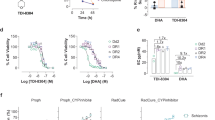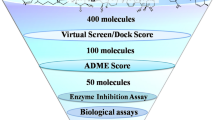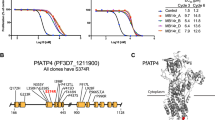Abstract
Plasmepsin V, an essential aspartyl protease of malaria parasites, has a key role in the export of effector proteins to parasite-infected erythrocytes. Consequently, it is an important drug target for the two most virulent malaria parasites of humans, Plasmodium falciparum and Plasmodium vivax. We developed a potent inhibitor of plasmepsin V, called WEHI-842, which directly mimics the Plasmodium export element (PEXEL). WEHI-842 inhibits recombinant plasmepsin V with a half-maximal inhibitory concentration of 0.2 nM, efficiently blocks protein export and inhibits parasite growth. We obtained the structure of P. vivax plasmepsin V in complex with WEHI-842 to 2.4-Å resolution, which provides an explanation for the strict requirements for substrate and inhibitor binding. The structure characterizes both a plant-like fold and a malaria-specific helix-turn-helix motif that are likely to be important in cleavage of effector substrates for export.
This is a preview of subscription content, access via your institution
Access options
Subscribe to this journal
Receive 12 print issues and online access
$189.00 per year
only $15.75 per issue
Buy this article
- Purchase on Springer Link
- Instant access to full article PDF
Prices may be subject to local taxes which are calculated during checkout





Similar content being viewed by others
References
Boddey, J.A. et al. An aspartyl protease directs malaria effector proteins to the host cell. Nature 463, 627–631 (2010).
Russo, I. et al. Plasmepsin V licenses Plasmodium proteins for export into the host erythrocyte. Nature 463, 632–636 (2010).
Marti, M., Good, R.T., Rug, M., Knuepfer, E. & Cowman, A.F. Targeting malaria virulence and remodeling proteins to the host erythrocyte. Science 306, 1930–1933 (2004).
Hiller, N.L. et al. A host-targeting signal in virulence proteins reveals a secretome in malarial infection. Science 306, 1934–1937 (2004).
Boddey, J.A. & Cowman, A.F. Plasmodium nesting: remaking the erythrocyte from the inside out. Annu. Rev. Microbiol. 67, 243–269 (2013).
Sleebs, B.E. et al. Inhibition of Plasmepsin V activity demonstrates its essential role in protein export, PfEMP1 display, and survival of malaria parasites. PLoS Biol. 12, e1001897 (2014).
Chang, H.H. et al. N-terminal processing of proteins exported by malaria parasites. Mol. Biochem. Parasitol. 160, 107–115 (2008).
Boddey, J.A., Moritz, R.L., Simpson, R.J. & Cowman, A.F. Role of the Plasmodium export element in trafficking parasite proteins to the infected erythrocyte. Traffic 10, 285–299 (2009).
Sargeant, T.J. et al. Lineage-specific expansion of proteins exported to erythrocytes in malaria parasites. Genome Biol. 7, R12 (2006).
Elsworth, B. et al. PTEX is an essential nexus for protein export in malaria parasites. Nature 511, 587–591 (2014).
Beck, J.R., Muralidharan, V., Oksman, A. & Goldberg, D.E. PTEX component HSP101 mediates export of diverse malaria effectors into host erythrocytes. Nature 511, 592–595 (2014).
Klemba, M. & Goldberg, D.E. Characterization of plasmepsin V, a membrane-bound aspartic protease homolog in the endoplasmic reticulum of Plasmodium falciparum. Mol. Biochem. Parasitol. 143, 183–191 (2005).
Gazdik, M. et al. The effect of N-methylation on transition state mimetic inhibitors of the Plasmodium protease, plasmepsin V. Med. Chem. Commun. 6, 437–443 (2015).
Masic, L.P. Arginine mimetic structures in biologically active antagonists and inhibitors. Curr. Med. Chem. 13, 3627–3648 (2006).
Peterlin-Mašič, L. & Kikelj, D. Arginine mimetics. Tetrahedron 57, 7073–7105 (2001).
Sleebs, B.E. et al. Transition state mimetics of the Plasmodium export element are potent inhibitors of Plasmepsin V from P. falciparum and P. vivax. J. Med. Chem. 57, 7644–7662 (2014).
Kay, J., Meijer, H.J., ten Have, A. & van Kan, J.A. The aspartic proteinase family of three Phytophthora species. BMC Genomics 12, 254 (2011).
Meyers, M.J. & Goldberg, D.E. Recent advances in plasmepsin medicinal chemistry and implications for future antimalarial drug discovery efforts. Curr. Top. Med. Chem. 12, 445–455 (2012).
Athauda, S.B. et al. Enzymic and structural characterization of nepenthesin, a unique member of a novel subfamily of aspartic proteinases. Biochem. J. 381, 295–306 (2004).
Haque, T.S. et al. Potent, low-molecular-weight non-peptide inhibitors of malarial aspartyl protease plasmepsin II. J. Med. Chem. 42, 1428–1440 (1999).
Ghosh, A.K. et al. Structure-based design: Potent inhibitors of human brain memapsin 2 (β-secretase). J. Med. Chem. 44, 2865–2868 (2001).
Johansson, P.-O. et al. Design and synthesis of potent inhibitors of plasmepsin I and II: X-ray crystal structure of inhibitor in complex with plasmepsin II. J. Med. Chem. 48, 4400–4409 (2005).
Boddey, J.A. et al. Role of Plasmepsin V in export of diverse protein families from the Plasmodium falciparum exportome. Traffic 14, 532–550 (2013).
James, M.N. & Sielecki, A.R. Structure and refinement of penicillopepsin at 1.8 A resolution. J. Mol. Biol. 163, 299–361 (1983).
Meanwell, N.A. Synopsis of some recent tactical application of bioisosteres in drug design. J. Med. Chem. 54, 2529–2591 (2011).
Schulze, J. et al. The Plasmodium falciparum exportome contains non-canonical PEXEL/HT proteins. Mol. Microbiol. 10.1111/mmi.13024 (9 May 2015).
Shea, M. et al. A family of aspartic proteases and a novel, dynamic and cell-cycle-dependent protease localization in the secretory pathway of Toxoplasma gondii. Traffic 8, 1018–1034 (2007).
Xiao, H. et al. The zymogen of plasmepsin V from Plasmodium falciparum is enzymatically active. Mol. Biochem. Parasitol. 197, 56–63 (2014).
Baum, J. et al. A conserved molecular motor drives cell invasion and gliding motility across malaria life cycle stages and other apicomplexan parasites. J. Biol. Chem. 281, 5197–5208 (2006).
Bianco, A.E. et al. A repetitive antigen of Plasmodium falciparum that is homologous to heat shock protein 70 of Drosophila melanogaster. Proc. Natl. Acad. Sci. USA 83, 8713–8717 (1986).
Kabsch, W. XDS. Acta Crystallogr. D Biol. Crystallogr. 66, 125–132 (2010).
Evans, P.R. An introduction to data reduction: space-group determination, scaling and intensity statistics. Acta Crystallogr. D Biol. Crystallogr. 67, 282–292 (2011).
Evans, P.R. & Murshudov, G.N. How good are my data and what is the resolution? Acta Crystallogr. D Biol. Crystallogr. 69, 1204–1214 (2013).
McCoy, A.J. et al. Phaser crystallographic software. J. Appl. Crystallogr. 40, 658–674 (2007).
Bunkóczi, G. & Read, R.J. Improvement of molecular-replacement models with Sculptor. Acta Crystallogr. D Biol. Crystallogr. 67, 303–312 (2011).
Ostermann, N., Gerhartz, B., Worpenberg, S., Trappe, J. & Eder, J. Crystal structure of an activation intermediate of cathepsin E. J. Mol. Biol. 342, 889–899 (2004).
Emsley, P. & Cowtan, K. Coot: model-building tools for molecular graphics. Acta Crystallogr. D Biol. Crystallogr. 60, 2126–2132 (2004).
Adams, P.D. et al. PHENIX: a comprehensive Python-based system for macromolecular structure solution. Acta Crystallogr. D Biol. Crystallogr. 66, 213–221 (2010).
Acknowledgements
We thank the Red Cross Blood Service (Melbourne, Australia) for supply of blood and the Australian Synchrotron and Commonwealth Scientific and Industrial Research Organisation Crystallization Facility. This work was supported by the Victorian State Government Operational Infrastructure Support and Australian Government National Health and Medical Research Council (NHMRC) Independent Research Institute Infrastructure Support Scheme, the Australian Cancer Research Foundation and the NHMRC (grants 1057960 (A.F.C.), 637406 (A.F.C.) and 1010326 (J.A.B.)). We thank the University of Melbourne for the provision of an Australian Postgraduate Award to M.G. A.F.C. is supported as a Howard Hughes International Scholar, P.E.C. is supported as an National Health and Medical Research Council of Australia Senior Research Fellow, and J.A.B. is supported as an Australian Research Council Queen Elizabeth II Fellow. We thank G. Lessene for useful discussions and Jacobus Pharmaceuticals for providing WR99210.
Author information
Authors and Affiliations
Contributions
A.N.H., B.E.S., J.A.B. and A.F.C. designed the experiments and wrote the manuscript. A.N.H. expressed, characterized, purified and crystallized plasmepsin V. B.E.S. and M.G. designed and synthesized WEHI-842. T.T. provided expert advice and supervision with respect to the molecular biology. P.E.C. collected X-ray data and solved and built the structure. P.E.C., A.N.H., B.J.S. and Y.X. did structural analysis of plasmepsin V with bound WEHI-842. B.J.S. and A.N.H. obtained enzyme kinetic data. M.T.O'N., S.L. and J.A.B. obtained biological data on the effect of WEHI-824. K.L. obtained surface plasmon resonance data. T.N. performed and analyzed proteomic experiments.
Corresponding authors
Ethics declarations
Competing interests
The authors declare no competing financial interests.
Integrated supplementary information
Supplementary Figure 1 Expression and purification of functional P. vivax and P. falciparum plasmepsin V.
(a) First panel, cleavage of fusion tag from recombinant P. vivax plasmepsin V. Lane 1, P. vivax plasmepsin V prior to TEV (tobacco etch virus protease) cleavage, Lane 2, TEV, Lane 3, P. vivax plasmepsin V/TEV digest and Lane 4, control digest (no plasmepsin V). RD, reducing sample buffer. ND, non-reducing sample buffer. Cleaved tag is present at 20 kDa. Second panel, size exclusion chromatography (SEC) purification of monomeric P. vivax plasmepsin V. 1, 2 and 3 show key fractions from elution profile. Third panel, purified recombinant P. vivax plasmepsin V under reducing and non-reducing conditions. Fourth panel, purified inactive recombinant P. vivax plasmepsin V with mutation of D>N in the active site under reducing and non-reducing conditions. Fifth panel, Purified recombinant P. falciparum plasmepsin V under reducing and non-reducing conditions. (b) Partial sequence alignment of P. vivax and P. falciparum plasmepsin V. P. vivax plasmepsin V expressed from the prosequence (R35) to the C-terminus of the enzyme domain (R476). P. falciparum plasmepsin V was expressed with the five most C-terminal residues of the prosequence adjacent prior to the enzyme domain. (c) Activity of P. falciparum recombinant plasmepsin V using KAHRP PEXEL peptide with and without mutations of RL>A, R>K and L>I. (d) Activity of P. vivax plasmepsin V using KAHRP PEXEL peptide (RTLAQ) and PEXEL mutations RL>A, R>K and L>I. (e) P. vivax plasmepsin V with D>N mutation is inactive. (f-k) Michaelis–Menten kinetics of P. vivax and P. falciparum plasmepsin V. (f) and (g) Rate of PEXEL peptide cleavage by plasmepsin V. P. falciparum (f) and P. vivax plasmepsin V (g). (h) and (i) Burk-Lineweaver plot of the velocity of plasmepsin V as a function of substrate concentration for P. falciparum (h) and P. vivax (i) plasmepsin V. (j) and (k) Kinetics of substrate cleavage for P. falciparum (j) P. vivax plasmepsin V (k). (l) Summary of P. falciparum and P. vivax plasmepsin V kinetic values.
Supplementary Figure 2 Surface plasmon resonance analysis of WEHI-916 and WEHI-842 and effect of WEHI-842 on global protein synthesis in P. falciparum.
(a) and (b) Representative Surface plasmon resonance sensorgrams showing direct binding kinetics of WEHI-916 (a) and WEHI-842 (b) to P. vivax plasmepsin V. Binding to plasmepsin V at each concentration is illustrated by coloured curves with fit curves overlaid in black. (c) Trophozoites treated with WEHI-842 for 3 hr show no defect in protein synthesis (35S Autoradiograph). HSP70 levels were analysed as a loading and viability control (middle panel). The effect on PfEMP3-GFP processing was also examined by immunoblot and black arrow is uncleaved protein, red arrow is signal peptidase cleaved protein and blue arrow is PEXEL cleaved protein. A GFP only remnant in the food vacuole is also indicated. (d) Schematic of PfEMP3-GFP expressed in transgenic parasites showing the positions of processing.
Supplementary Figure 3 Structural features for P. vivax plasmepsin V.
(a) Putty diagram illustrating differences in B-factors within the structure of P. vivax plasmepsin V. Increased B-factors are shown as increased thickness and colour transition (blue to red). (b) Schematic showing surface electrostatic potential for P. vivax plasmepsin V. Top left image shows a face of the molecule enabling a full frontal view of the substrate binding cleft region. The top right hand side image is rotated 90˚ clockwise showing a face of the molecule with a side view of the substrate-binding cleft. There is a large area of negative electrostatic potential predicted to be adjoining the edge of the cleft and at the bottom. The bottom right hand side image represents the back face of the molecule with the substrate binding cleft facing into the page. The bottom left hand side image is of the alternative side face of P. vivax plasmepsin V and is predicted to have an extensive area of positive electrostatic surface potential.
Supplementary Figure 4 Sequence alignments of plasmepsin V from various Plasmodium species.
Alignments were conducted using clustal w and presented using the boxshade server (http://www.ch.embnet.org/software/BOX_form.html). Pv = Plasmodium vivax, Pcy = Plasmodium cynomolgi, Pi = Plasmodium inui, Pk = Plasmodium knowlesi, Pf = Plasmodium falciparum, Pchch = Plasmodium chabaudi chabaudi, Pvv = Plasmodium vinckei vinckei, Pyy = Plasmodium yoelii yoelii and Pb = Plasmodium berghei.
Supplementary Figure 5 Alignment of P. vivax plasmepsin V and P. falciparum plasmepsin II sequences and potential secondary-structural Nap insert and Flap elements.
(a) The alignment P. vivax plasmepsin V and P. falciparum plasmepsin II was made using the ESPript program (http://espript.ibcp.fr). The sequence corresponding to the region of the enzyme domains with crystal structures have been compared. Although P. vivax plasmepsin V and P. falciparum plasmepsin II have poor sequence homology most of the secondary structural elements are maintained. PDB file reference for P. falciparum plasmepsin II was 1LF4. (b) Alignment and structure of the Nap insert of plasmepsin V for P. vinckei (Pvvpmv), P. berghei (Pbpmv), P. yoelii (Pyypmv), P. falciparum (Pfpmv), P. vivax (Pvpmv), P. cynomolgi (Pcypmv), P. inui (Pipmv), P. knowlesi (Pkpmv) showing strong homology. Lower alignment shows Theileria ovis (ThoASP5), Babesia bovis (BboASP5), P. vivax (Pvpmv), Nepenthus distillatoria (NdNEP1), Nepenthus distillatoria (NdNEP2), Toxoplasma gondii (TgASP5) and low homology in the Nap insert. (c) Alignment and structure of the P. vivax flap region from plasmepsin V and other related proteases. P. vinckei (Pvvpmv), P. inui (Pipmv), P. cynomolgi (Pcypmv), P. knowlesi (Pkpmv), P. falciparum (Pfpmv), P. berghei (Pbpmv), P. chabaudi (Pchchpmv), P. yoelii (Pyypmv), P. vivax (Pvpmv), Theileria ovis (ThoASP5), Babesia bovis (BboASP5), Toxoplasma gondii (TgASP5), Nepenthus distillatoria (NdNEP1). (d) Model of flap regulation for plasmepsin V.
Supplementary information
Supplementary Text and Figures
Supplementary Figures 1–5 and Supplementary Note (PDF 3451 kb)
Supplementary Data Set 1
Supplementary Data Set 1 (PDF 2866 kb)
Supplementary Data Set 2
Supplementary Data Set 2 (PDF 2355 kb)
Rights and permissions
About this article
Cite this article
Hodder, A., Sleebs, B., Czabotar, P. et al. Structural basis for plasmepsin V inhibition that blocks export of malaria proteins to human erythrocytes. Nat Struct Mol Biol 22, 590–596 (2015). https://doi.org/10.1038/nsmb.3061
Received:
Accepted:
Published:
Issue Date:
DOI: https://doi.org/10.1038/nsmb.3061
This article is cited by
-
Synthesis of 2-aminopyridopyrimidinones and their plasmepsin I, II, IV inhibition potency
Chemistry of Heterocyclic Compounds (2020)
-
Pan-active imidazolopiperazine antimalarials target the Plasmodium falciparum intracellular secretory pathway
Nature Communications (2020)
-
Guided STED nanoscopy enables super-resolution imaging of blood stage malaria parasites
Scientific Reports (2019)
-
Plasmepsin V cleaves malaria effector proteins in a distinct endoplasmic reticulum translocation interactome for export to the erythrocyte
Nature Microbiology (2018)
-
Drugs in Development for Malaria
Drugs (2018)



